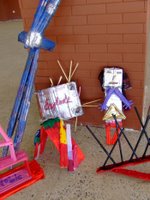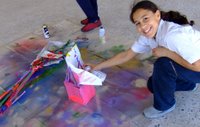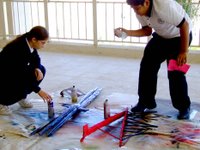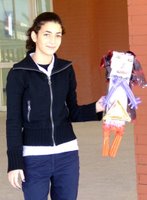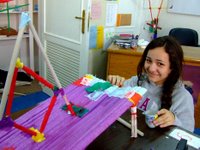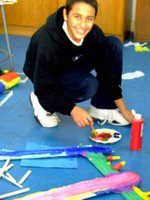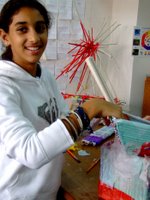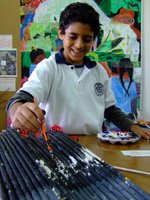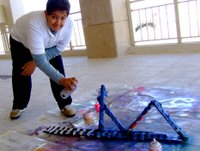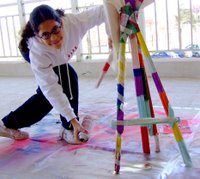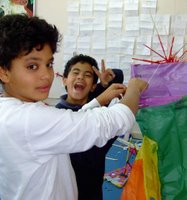Tuesday, November 28, 2006
Saturday, November 25, 2006
Tube Sculptures Nov 2006
 Here's a look at the colorful chaos that quickly ensued after assigning the Tube Sculpture Project. I had to improvise "storage space" by taping off areas of the room.
Here's a look at the colorful chaos that quickly ensued after assigning the Tube Sculpture Project. I had to improvise "storage space" by taping off areas of the room.The first step of this ongoing project is to have the students roll 50 tubes each, out of various-sized newsprint paper.

This took them roughly a week. Then, we complete a classroom exercise on expressive line were they divide a large sheet of paper into 16 boxes. At the bottom of each box, the students were to write different descriptive or expressive word.
Finally, inside each box the student was to create a line drawing to express the various words.

In this way, they would realize that their tubes are 3-D lines in space and that their sculptures, like the drawings could express an emotion or idea without referencing something in the real world, or being too literal. I didn't want them to build a house or stick figure with these tubes. I wanted to challenge them with possibly their first attempt at abstraction.

 So, we began the sculpting process after each student chose a descriptive word and created a sketch of how they would express that word with their tube sculpture.
So, we began the sculpting process after each student chose a descriptive word and created a sketch of how they would express that word with their tube sculpture.It took them about 3 weeks to construct the sculptures. They were restricted to using Elmer's, string, and art tissue paper. It makes the building go slower, but avoids sloppy
 craftsmanship since their initial inclination is to use loads of tape and staples to wrap and bundle the tubes into messy forms.
craftsmanship since their initial inclination is to use loads of tape and staples to wrap and bundle the tubes into messy forms.After weeks of tedious constructing, the students were finally able to paint the sculptures. Again another restriction had to be imposed here to avoid shortcuts and sloppy craftsmanship.
 The students were aware that our final step would be to apply spray paint, but they were told in advance that a base coat of regular paint had to be applied to any exposed newsprint. In other words, they weren't required to paint over the art tissue paper, but newsprint had to be covered with paint before they could spray paint. As I explained to them, it makes for a more finished looking sculpture.
The students were aware that our final step would be to apply spray paint, but they were told in advance that a base coat of regular paint had to be applied to any exposed newsprint. In other words, they weren't required to paint over the art tissue paper, but newsprint had to be covered with paint before they could spray paint. As I explained to them, it makes for a more finished looking sculpture.I tried to encourage spray painting plans that included the use of taped off areas and templates. This student used a circle template to create polka dots. Another student achieved a criss-cross look by using long strips of tape over blue paint, then spray painting silver.

 A few students did such a great, detailed job of painting with tempera and a brush, that we decided spray painting wasn't necessary at all.
A few students did such a great, detailed job of painting with tempera and a brush, that we decided spray painting wasn't necessary at all.I am so proud of these middle school students. They've tackeled challenging subject matter and tedious technique, creating some really great work. Hopefully, they will realize it next week when we display them throughout the AISE hallways.



